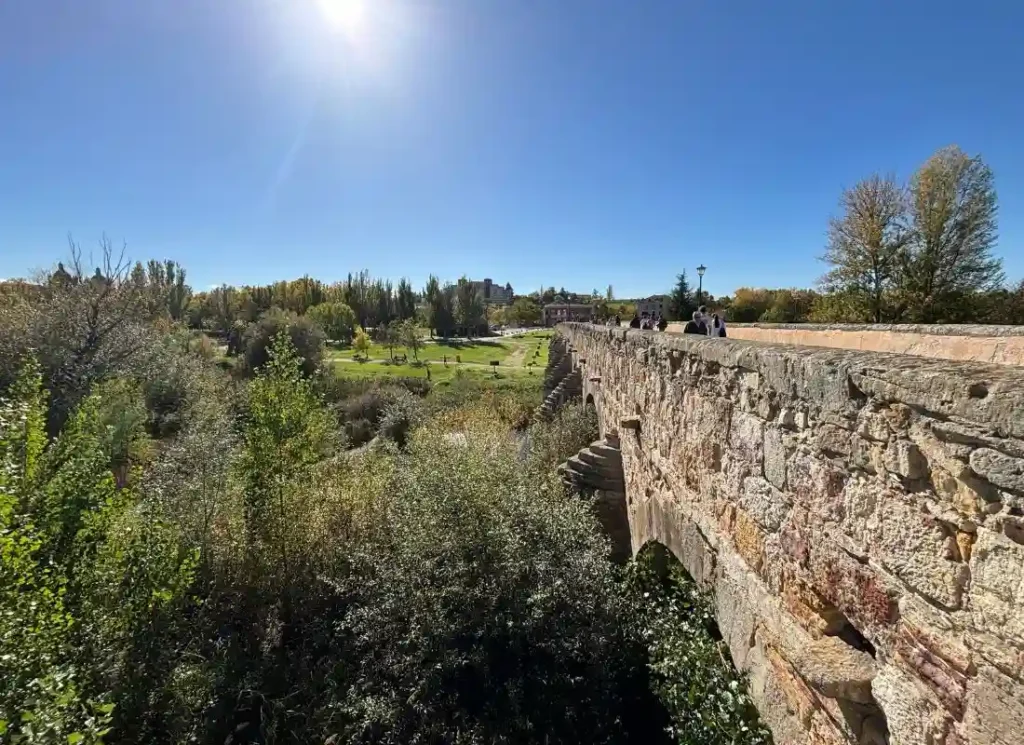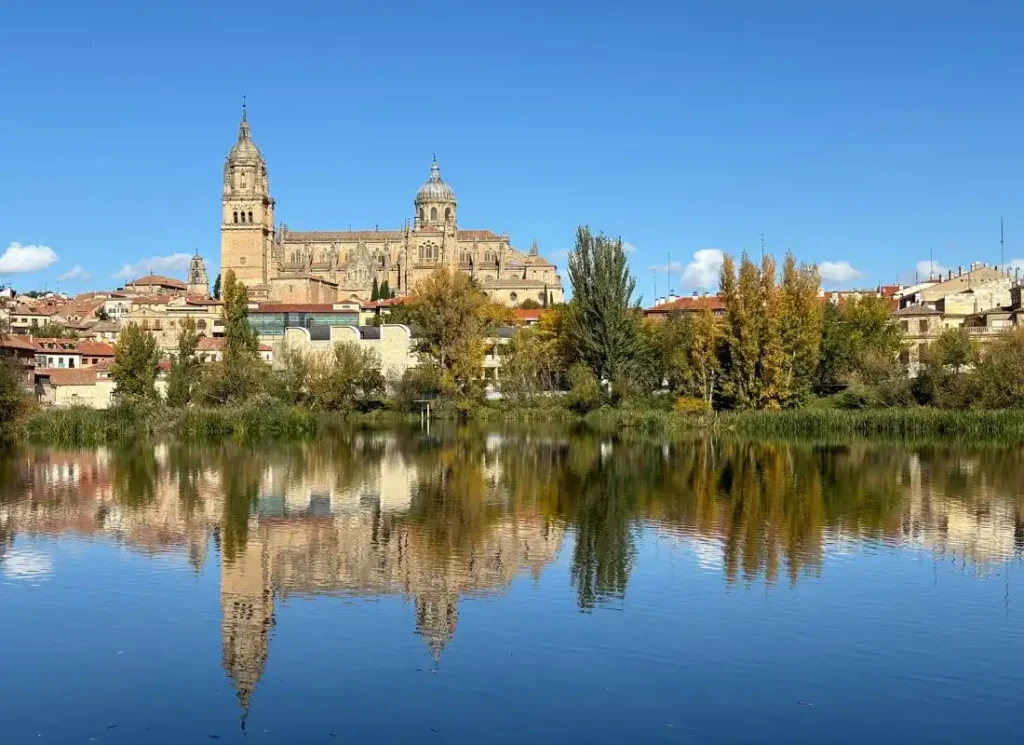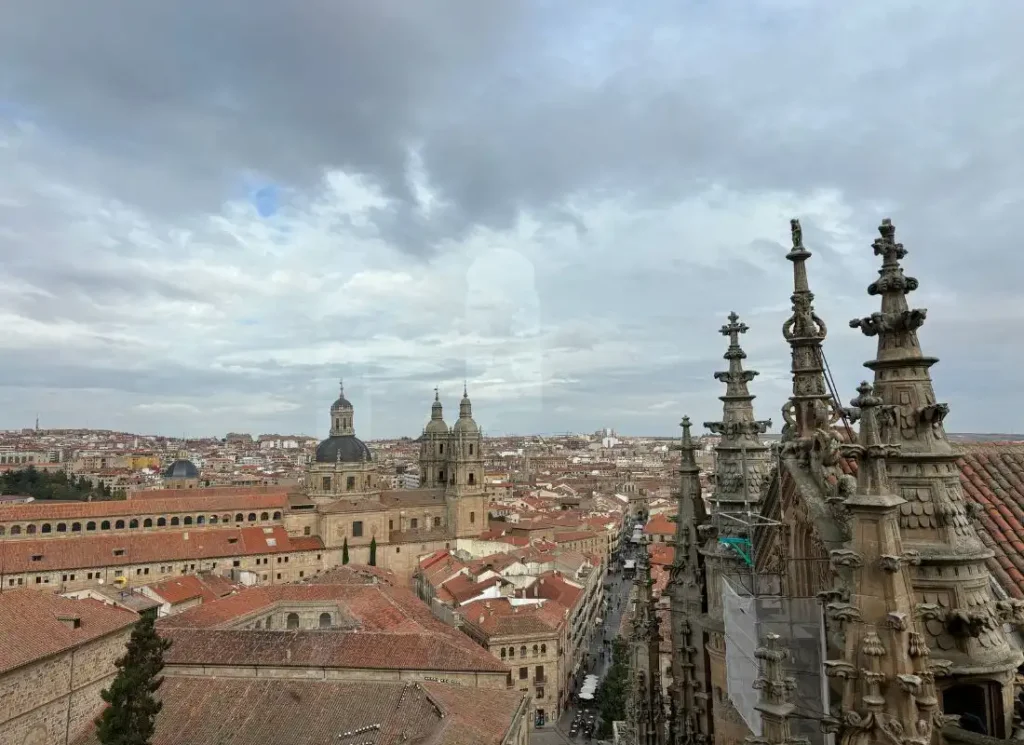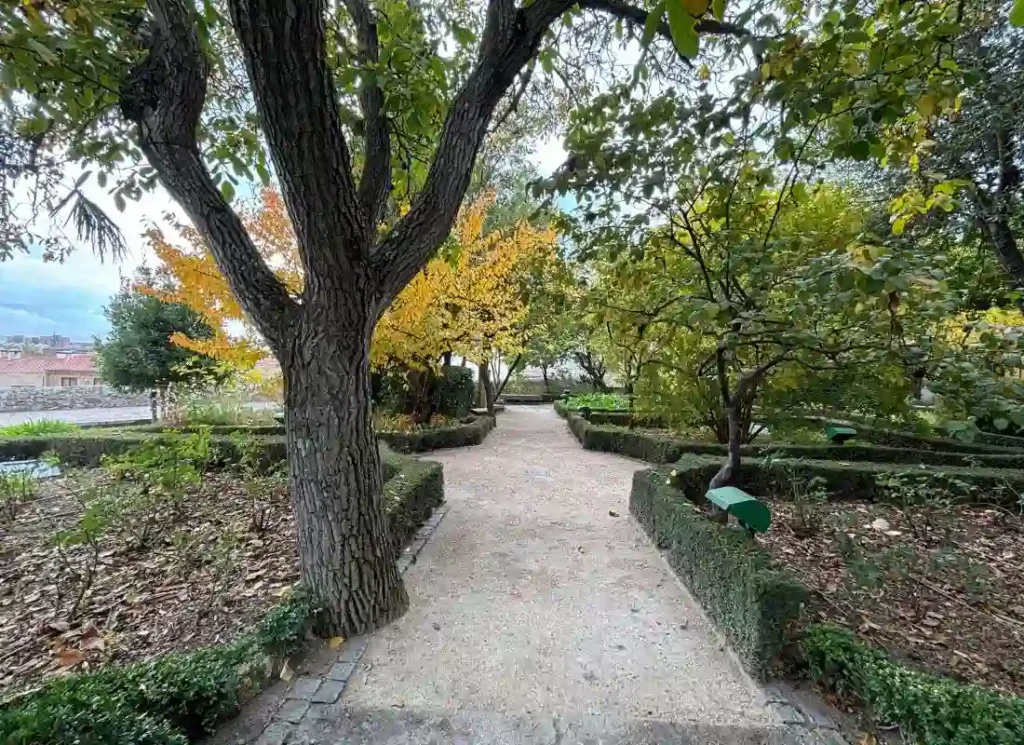Salamanca is a city in northwestern Spain, around two hours from Madrid by bus, train or car. At first glance might not strike you as somewhere to put on your list of places to visit in Spain, but when I visited last weekend I was pleasantly surprised by the number of things there are to do in Salamanca.
Salamanca is best known in Spain for being a university town. The University of Salamanca is the oldest in Spain, and is still one of Spain’s best ranking universities today. But this is just a small part of Salamanca’s history, and whilst the university students are notable milling around the city, there is much more to do in Salamanca than its reputation would have you believe.
The city itself is a UNESCO World Heritage Site, and everywhere you go you are surrounded by stunning romanesque and gothic architecture.
I went to Salamanca to meet my parents who were travelling around Spain (yes, apparently the love of travel runs in the family!). They arrived a couple of days before me and, after a visit to the local tourist offices (yes, there are two, one for Salamanca city and one for the region of Castilla y León), my parents came away armed with a whole list of sights worth seeing in Salamanca.
After visiting a lot of them, I have to agree that, yes, there is a lot worth visiting in Salamanca. What’s even better is that everything is really reasonably priced for entry, generally between 3-5€ per person.
➡️ Use Booking.com to find your accommodation in Salamanca
*this article may contain affiliate links
Salamanca Table of Contents
🇪🇸 Read more about Spain: 32 Things to Do in Barcelona
📍 If you don’t have much time in your Spain itinerary, you can take a day trip to Salamanca from Madrid
17 Things to Do in Salamanca
Plaza Mayor
Plaza Mayor is, of course, the main square in Salamanca. It’s one of the most beautiful squares in Spain (according to a friend of my dad’s who recommended we go there, and has seen may more squares in Spain than I have, so let’s take his word for it!). It’s absolutely huge and very picturesque, especially at night time when the buildings are lit up.
The square is lined with tapas bars that, whilst quite popular with tourists (the prices speak for themselves), still feel quite authentically Spanish. Other than eat or drink (the quintessentials of Spanish culture), really the only thing to do here is awe at the incredible buildings (worth it, though).

Roman Bridge
The roman bridge in Salamanca is quite a big feature of the city, and I thought it was really impressive. According to my parents it was not as big or impressive as the roman bridges in Merida or Cordoba (apparently they are roman bridge experts these days), but it was still pretty and gives you a great view of the river and of the city.
Cathedral(s) of Salamanca
You’ll hear people talking about the Old Cathedral and the new Cathedral in Salamanca, and whilst they are two distinct buildings they are right beside each other (with the Ieronimus tower sandwiched between), so it can be difficult to tell which is which at the beginning.
In terms of going inside both cathedrals, I’d say it’s probably only worth the entrance if you are visiting for religious reasons. If you’re more here for the pretty views and artwork (hello, yep, that’s me!) you can get great views of the interior of both stunning buildings from a trip to Ieronimus tower (I’ll talk more about that below).

Mirador del Embarcadero
Speaking of the cathedral(s), you can get an incredible view of it from the Mirador del Embarcadero, also known as the cathedral viewpoint or mirador a la catedral. We went here after crossing the roman bridge and it was well worth the short walk down the Tormes River. On a still day, the reflection of the cathedral in the water is just stunning.
Because we visited at the end of autumn, the sun was quite low which meant the viewpoint itself was shaded, although the cathedral was still lit up with sunshine.
Around Salamanca there are phone holders that help you to take a selfie with various landmarks in the background, and there’s one here.
Ieronimus Tower
The Ieronimus Tower advertises itself as a trip up to the top of the bell tower between the two cathedrals of Salamanca, and whilst it is, you also get to take a trip through both cathedrals. At just 4€ per person, I’d say this is the best thing you can do in Salamanca in terms of value for money, and if you could only do one thing in Salamanca, I’d recommend doing this.
You spiral up the bell tower, guided by a traffic light system going up and down (because the stairs are so thin they can only be one-way). Part-way up, you’re taken on a side quest through the balcony seats of both cathedrals that are each equally as stunning as the other.
(Whilst the stairs are steep, they’re completely manageable for most levels of fitness, but of course not wheelchair accessible.)
There’s loads of great historical information throughout the tour, but it is only in Spanish. There is a QR code to scan to read it in other languages, but there’s no cell service and the wifi didn’t work for us, either.

Casa de las Conchas
Casa de las Conchas (or “the house of the shells” in English) is Salamanca’s public library. The outside of the historic building is quite quirky, featuring a pattern of 3D scallop shells, whilst inside is a perfectly ordinary library. We did pop in to the public library, but it was modernised, functional, and, of course, full of studious university students. The outside of the building and the courtyard within is much more impressive.
University of Salamanca
As I mentioned in the introduction, the University of Salamanca is the oldest university in Spain and both the university and the city itself have a great reputation for students. At certain times of year it is possible to tour the buildings, but what’s more impressive is the external architecture and the exterior design of the buildings. Salamanca must be one of the most beautiful universities around; there are moments when it feels like you are walking through the grounds of Hogwarts.
🇪🇸 Read more about Spain: A Full Packing Guide for Travelling in Spain
Palacio de Monterrey
The Palacio de Monterrey, or Monterrey Palace, is an unfinished renaissance palace that has more recently been turned into a museum of sorts, housing an impressive collection of renaissance artwork. It’s one of the pricier things to do in Salamanca at 9.50€ per ticket (which is not exactly extortionate, but an exception to the general overview of prices I gave at the beginning of this article!).
Central Market of Salamanca
The Central Market of Salamanca (or Mercado Central) is a large market close to Plaza Mayor. The impressive building is surrounded by colourful stain-glass. I didn’t get the chance to visit here myself, but my parents went and, very helpfully to their blogger daughter, took some pictures for me!
Convento de San Esteban
The Convento de San Esteban is a Dominican Monastery in the south of the city. It is very beautiful and peaceful inside, with interesting and inspirational quotes in large letters across the walls. There is a beautiful church attached which you are welcome to look around, but silence is requested. There is also a small museum which is home to several artefacts from the monastery, but personally we didn’t stay in that part for long.
Just outside of the monastery is Plaza del Concilio de Trento, which is one of the only truly shaded gardens in Salamanca, which I imagine might provide some much-wanted relief from the sun during the summer months!
Huerto de Calixto y Melibea
The Huerto de Calixto y Melibea is a beautiful botanical garden close to the centre of Salamanca city. It feels like a sort of calm escape, not that there’s much you’d want to escape from in Salamanca. There are plenty of seating areas and great views over the city, although the walls are not high and there’s a steep drop below, so make sure you keep an eye out if you’re visiting with kids!

Casa Lis (Art Nouveau & Art Deco Museum of Salamanca)
Casa Lis is the museum of art nouveau and art deco in Salamanca. The building has an absolutely incredible stain glass ceiling which is just stunning to look at, but sadly they have a very strict “no photos” policy inside. They did have some good collections when we went to visit, but the ceiling was by far the best thing to look at in there.
There’s also a cafe inside with stain glass windows, but the stain glass comes up quite high which blocks what could be a very nice view of the river beyond.
Cielo de Salamanca
The Cielo de Salamanca (”sky of Salamanca”) is a piece of artwork in one of Salamanca’s many university buildings. It’s quite tucked out of the way, so you wouldn’t find it unless you were looking for it. The artwork depicts the night sky above, which has allowed historians and astrologists to accurately date its creation based on when the stars in the sky were in that exact position above the building. That exact constellation was visible from the building in 2022, and will be visible there again in 2060.

Scala Coeli (Torres de la Clerecia)
The Scala Coeli, also known as the Torres de la Clerecia, is another bell tower you can climb in Salamanca. Again, it is very cheap to enter and gives you a really good view of the cathedral and one of the university courtyards, but it wasn’t as impressive as the Ieronimus Tower.
Plaza de Anaya
The Plaza de Anaya is a gorgeous square between the cathedral and several buildings belonging to the University of Salamanca. It’s huge, lit up beautifully at night, and is often where group tours or walking tours begin or end. You’ll see (and overhear, if you’re lucky!) a lot of snippets of history being told as you wander through Plaza de Anaya.
Where to Eat in Salamanca
Something we found whilst staying in Salamanca was a distinct lack of good places to eat. Even browsing on Google Maps, you’ll see that a lot of restaurants have ratings in the threes or low point fours. Every night it took us a lot of researching, wandering and browsing to find somewhere to eat (I didn’t say my parents are picky, you did!).
To save you the same burden, I’ve listed a few places below that we found to be good places to eat in Salamanca.
Dominicos
Dominicos is a cafe/restaurant just around the corner from the hotel we stayed at in Salamanca. It has low reviews on Google Maps but had just changed hands when my parents arrived, so they decided to try it and then proceeded to eat either breakfast, lunch or dinner there almost every day! I have to admit, all of the food I tried there was really good.
Origen
Origen is a more up-market restaurant, with a very classy vibe and price tags to match, however everything we ate there was delicious.
Cafe Atelier
Cafe Atelier is a vegetarian restaurant with the world’s friendliest waiter. It’s more suited to lunch than dinner, as the food is sort of pre-prepared breads and tapas.
Mesón Cervantes
Mesón Cervantes is a tapas place in Plaza Mayor that was recommended to me by a friend who is actually from Salamanca. The food and the vibes were quite traditionally Spanish.
Delicatessen
Delicatessen was a restaurant that, honestly, looked kind of tacky on the outside, but it had some of the best food we’d eaten for our entire trip in Salamanca!
FAQs About Salamanca
Is Salamanca a good destination for a weekend trip?
Absolutely! Whilst there are many things to do in Salamanca, you can easily fit them all into a really interesting and vibrant weekend trip (or spread them out over a leisurely week, if you like!).
What is the best way to reach Salamanca from Madrid?
You can get to Salamanca from Madrid by train, bus, or car. The train is usually the most convenient option, with a journey time of around 1.5 to 2 hours, but it is more expensive than the bus. The bus usually takes about 2.5 hours.
Is Salamanca a walkable city?
Yes, Salamanca is very walkable. Most major attractions, like the Plaza Mayor, cathedrals, and university buildings, are within easy walking distance, and it’s quite a flat city.
Are there any good day trips from Salamanca?
Yes, there is plenty more to see in the region of Castilla y León. Places like Zamora, Avila, and Ciudad Rodrigo make great day trips from Salamanca, to name a few.
What is Salamanca known for in Spanish history?
Salamanca is known for its prestigious University of Salamanca, founded in 1218, which is one of the oldest universities in Europe. The city is also known for its impressive architecture, and its influence on Spain’s intellectual and cultural history.
Conclusion
Salamanca is a beautiful city that offers visitors a rich history, stunning architecture, and an alive but calm atmosphere influenced by its university culture. Whether you’re just visiting for a weekend or including Salamanca as part of a longer Spanish itinerary, Salamanca is not to be missed as one of the highlights of Castilla y León and an easy weekend trip from Madrid.
